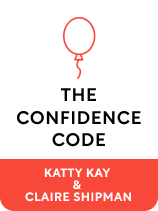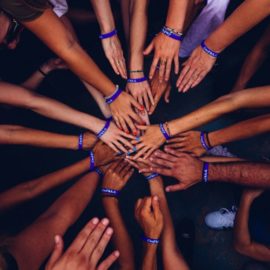

This article is an excerpt from the Shortform book guide to "The Confidence Code" by Katty Kay and Claire Shipman. Shortform has the world's best summaries and analyses of books you should be reading.
Like this article? Sign up for a free trial here .
What is The Confidence Code about? Why do girls tend to grow up less confident than boys?
In their book The Confidence Code, journalists and authors Katty Kay and Claire Shipman examine confidence—what it is, why it’s important, and why women seem predisposed to have less of it than men. While the book focuses on confidence in women, much of the confidence-building advice applies to men too.
Below is a brief overview of the key takeaways from The Confidence Code: The Science and Art of Self-Assurance—What Women Should Know by Katty Kay and Claire Shipman.
What Is Confidence?
Confidence is believing so strongly that you can do something that you’re driven to actually do it. In their book The Confidence Code, Katty Kay and Claire Shipman argue that confidence stems from mastery—you know you can do something because you’ve worked hard and pushed through past difficulties and failures.
- For example, when Katty learned to kiteboard, it was challenging. The kite would drag her around, she’d fall, she’d get frustrated, and she’d get sore. After a few years of practice, she figured out how the sport worked, and now she can do it confidently.
Confidence is contagious—once you’ve mastered something, this gives you the confidence that you can master (or at least try) something else.
Why Confidence Matters
Confidence is important for three reasons:
1. If you don’t have it, you won’t act, even if you have the desire and skills to do so.
- For example, Jessica Grounds cofounded the organization Running Start, which teaches young women to run for office, because many smart, competent college-aged women who wanted to change the world were qualified but not confident enough to run.
2. It’s more important than competence (provided the gap between competence and confidence is small). Humans admire and respect people who display confidence, and when people genuinely believe they’re good at something (even if they’re objectively not) they naturally give off nonverbal cues and behave in ways that make them seem confident. Keeping your head down and working hard isn’t as visible.
- For example, in 2009, psychologist Cameron Anderson gave a group of students a list of historical events and names, some of which weren’t real. Anderson asked the students to check off the names and events they knew of. The students who picked the most fakes were the most overconfident but also the most influential and respected.
Interestingly, many confident-but-not-extremely-competent people never run into problems. Others don’t think they’re narcissistic because they’re not faking their confidence; they genuinely believe they’re as good as they think they are.
3. It contributes to emotional well-being. Being confident offers more rewards than professional or personal success. Confidence contributes to making you feel engaged, rewarded, accepted, fulfilled, and purposeful.
Women Are Less Confident Than Men
Researchers have found evidence that women have less confidence than men, and women tend to underestimate their abilities. Men tend to overestimate their abilities:
- Example #1: Columbia Business School found that on average, men think their performance is almost a third better than it actually is.
- Example #2: Marilyn Davidson of Manchester Business School found that her male students both expect and think they deserve higher salaries (on average $80,000) than what the women expect and think they deserve (on average $64,000).
Biological and Environmental Factors Affect Confidence
Confidence comes from biological factors (genetics, brain biology, and hormones) as well as environmental factors (upbringing, societal expectations, and so on).
Confidence and Genetics
Scientists estimate that 25-50% of our confidence comes from our genes. Four notable genes affect confidence and their variants are evenly distributed between genders.
Gene #1: The serotonin transporter (SLC6A4). This gene regulates serotonin levels in the body. Serotonin calms the amygdala, the two primitive parts of the brain responsible for fear and strong, often negative emotions that further survival. Serotonin also de-stresses the prefrontal cortex (the part of the brain responsible for, among other things, rational thought). A calmer prefrontal cortex makes you feel happier, less anxious, and more confident in your decision-making.
SLC6A4 comes in three variants that process serotonin: well, inefficiently, and poorly, respectively. People with the quick-processing variants are resilient, which helps them be confident, and people with the slow-processing one are at a higher risk of anxiety and depression
Gene #2: OXTR. This gene controls oxytocin levels. Oxytocin, like serotonin, aids the prefrontal cortex processes and calms the amygdala. Additionally, it encourages positive thoughts about others, which increases optimism. Optimism supports confidence because it’s easier to take risks if you believe things will turn out all right.
Like SLC6A4, this gene also has two variants. One makes people more resilient and outgoing; the other can lead to low self-esteem and low optimism.
Genes #3 and #4: COMT and DRD4. These genes control dopamine, which aids concentration and is linked to action and risk-taking.
COMT is responsible for clearing dopamine out of the prefrontal cortex and there are three variants that clear dopamine: quickly, medium speed, or slowly. When there’s excess dopamine in the prefrontal cortex (in times of stress), the brain shuts down, so the quick-clearing variant restores balance more quickly, aiding confidence.
DRD4 comes in two variants and those with DRD47R are more adventurous because the variant encourages pushing limits and extreme risk-taking.
Epigenetics
Even if you have genes that don’t enhance confidence, that doesn’t mean that you’re doomed to be under-confident. Certain genes related to character traits can turn on and off, depending on life experiences, thus changing our brain chemistry—and our confidence levels.
- For example, the authors have the same combination of confidence-related gene variants—slow-clearing COMT, resilient OXTR, and medium SLC6A4—but they have different personalities and find different things easier and harder because they’ve had different life experiences.
Brain Biology and Confidence
While there are no genetic differences between men and women—the confidence-related gene variants are evenly distributed between genders—the sexes do have physiological differences in their brains, think in different ways, and have different amounts of relevant hormones.
Women’s and men’s brain differ in the following ways:
- Women who have the poor processing SLC6A4 or the slow-clearing COMT variant are more likely to be anxious than men who have them.
- Women’s brains produce around half the serotonin men’s do.
- Women have larger cingulate gyrus (the part of the brain that spots mistakes, considers options, and worries).
- Most of women’s brain matter is in the frontal cortex (reasoning hub) and some of it is in the limbic cortex (emotional hub). Men’s brain matter is distributed throughout the brain and less than half is in the frontal cortex. This suggests the sexes process information differently.
- Women have more white brain matter (used for making connections) and men have more gray matter (used for solving isolated problems). Women’s white matter often functions better than men’s, particularly the white matter in the corpus callosum (the part of the brain that connects the left and right hemispheres of the brain). This suggests women can more easily use both sides of their brains, which helps them multitask.
- Women’s brains are more active than men’s, especially in the prefrontal and limbic cortex. This activity is probably responsible for women’s skills with empathy, collaboration, and multitasking, but also makes women more vulnerable to ruminating and confidence-killing anxiety.
- Women use the amygdala (primitive fear centers) associated with thoughts, emotions, and memory more often than the one associated with action in response to negative emotions. Men do the opposite.
Plasticity
All of us, regardless of age, can physically change our brains, which means that if you choose to change your thinking and mental habits, you can rewire yourself to be more confident, regardless of your genes or sex.
- For example, meditation can quiet and depower the amygdala. One experiment on stressed business people found that their amygdala actually shrank after meditation.
Hormones and Confidence
In the previous section, we looked at brain biology. Now, we’ll look at two hormones that affect confidence: testosterone and estrogen. Both men and women have testosterone, but post-puberty, men have around 10 times more than women.
Testosterone
Testosterone is responsible for muscle size, competition ability, speed, strength, and feelings of power. It’s also related to risk-taking and ignoring warnings. While these qualities aid confidence, testosterone has some downsides—it limits certain abilities, like cooperating and seeing other people’s points of view.
- For example, one study asked pairs of women to look at two images and agree on which was clearer. The pairs of women who received a testosterone supplement had more difficulty agreeing and were more often wrong.
Women can increase their testosterone levels by adopting male postures, like taking up space while sitting.
Estrogen
Estrogen encourages observation, social skills, and connection. Like testosterone, it has limitations too—it contributes to risk avoidance, which can kill confidence. However, risk aversion isn’t always bad—sometimes risks fail—and therefore estrogen’s effects can enhance performance and success.
- For example, one study found that over five years, women hedge fund managers’ investments did three times better than men’s.
Environment and Confidence
In the previous sections, you learned about how genetics, brain biology, and hormones affect confidence. But confidence isn’t a matter of nature versus nurture—both our biology and our environment affect us and neither will win out.
Seven environmental influences contribute to women having lower self-belief than men:
Influence #1: Expectations of “goodness.” Starting in elementary school or even younger at home, girls are rewarded for being “good”—quiet, neat, compliant, and well-behaved. Encouraging goodness discourages confidence-building behavior like taking risks, being rowdy, or teasing and roughhousing (both common ways boys play).
Influence #2: Fewer girls play sports. Sports are good for building confidence because playing them involves competing, winning, and losing, which have parallels with victories and setbacks throughout life (such as making a mistake at work.) However, fewer girls play sports than boys, and girls are six times more likely to quit their team than boys. This is because girls’ self-esteem drops more than boys’ during adolescence and losing makes them so uncomfortable they stop competing.
Influence #3: The rules change. Unlike in the classroom, in the workplace, academic achievement and competence are no longer the requirements for success. Instead, success requires self-promotion, political savvy, and pushing beyond nos. Many women aren’t skilled in these areas since they haven’t had practice in their upbringing.
Influence #4: Stereotype threat. When there’s a stereotype associated with a minority group, members of the group feel pressure to embody the stereotype. There are many negative stereotypes associated with women’s abilities. For example, women are stereotypically worse at math than men.
Influence #5: Systemic barriers. Women don’t have access to the same resources as men in the U.S. For example, American women earn more degrees than men and according to the Global Gender Gap, the U.S. is first in equality in educational attainment. There’s no lack of competence—but the U.S. is 67th in gender pay equality and 60th in political empowerment.
Influence #6: Body image expectations. Women’s confidence is strongly tied to physical appearance and they’re judged on their appearance more than men are. Women who don’t meet society’s beauty standards have a harder time in life.
- For example, obese girls are less likely to attend college than other girls, but obese boys are just as likely to attend as other boys.
Influence #7: Self-imposed obstacles. In addition to the six external influences that inhibit women more than men from developing confidence, women also assume certain burdens such as a desire to be likable (making us so scared of offending people we don’t act), overthinking (inhibiting our ability to act) internally attributing everything (chalking up anything that goes wrong as a personal failing), and perfectionism (unattainable, so you’ll always feel too inadequate to take action).
The Confidence Code
As you learned, both biological and environmental factors contribute to confidence, but confidence isn’t a fixed trait—you have to build it. Psychologists believe that 50% of confidence might come from choice and will.
The confidence code—the building blocks of confidence—consists of three principles:
- Don’t overthink.
- Act.
- Be authentic.
Practice adhering to the code using the following techniques:
Technique #1: Fail fast. Failing fast is a business strategy that involves trying lots of ideas, expecting that most of them will fail. This is useful as a confidence-building strategy because it inherently involves the same cycle of repeated attempts, failure, and risk-taking necessary for building confidence. Additionally, it combats perfectionism and inhibits overthinking because the cycles are so fast there’s simply not time.
Technique #2: Act, even when you’re uncertain. If you stay inactive in your comfort zone, you won’t improve or gain confidence. If you act, the worst thing that will happen is that you fail. You don’t have to take massive action—it’s fine to start this strategy with baby steps. For example, if you’re not confident about attending parties solo, first, go to a small event where you know people.
Technique #3: Think differently using thought exercises. For example, to control ruminating, whenever you find yourself doing it, think of three things you’ve done well that day.
Technique #4: Change your focus. Women tend to be more confident when they focus on others instead of themselves. Therefore, you can spur yourself to act by thinking about how taking action will benefit others. For example, if you’re nervous about public speaking, tell yourself you’re speaking on behalf of people or a group you care about.
Technique #5: Take credit. When you achieve something, don’t downplay it, attribute it to luck, or be self-deprecating. You deserve your achievements, so take credit for them. If you have trouble taking a compliment, say thank you and tell the person you appreciate them saying it. In moments when you lack confidence, remember these achievements—you’ll become more confident when you remember there’s proof you’ve been successful in the past.
Technique #6: Don’t take things personally. When someone criticizes you at work, remember that this criticism is directed at your work, not you. Also, recognize that women face some obstacles men don’t and this makes things harder for us. We’re not incompetent or less capable; our lives are harder and we don’t have access to the same resources.
Technique #7: Become more comfortable speaking up. You can improve your confidence and speaking abilities by using whatever speaking style is most comfortable, focusing on others, and avoiding upspeak (when the pitch of your voice rises at the end of a sentence, making it sound like you’re asking a question and are uncertain).
Technique #8: Do things differently if necessary. You don’t need to copy men or other people to be confident. If you have a new, more effective way of doing something, pursue it, even if you face criticism.
Technique #9: Don’t rely on external sources of confidence. There’s nothing wrong with comparing yourself to others and enjoying external validation, but it’s dangerous to rely on this as a source of confidence. You’re less likely to act if you fear the action will make people stop praising you, and you’ll be crushed when you don’t get enough praise.
Building Confidence in Others
In the previous section, you learned some techniques for building your confidence. In this final chapter, you’ll learn how to build confidence in your children and the women you know.
Building Confidence in Children
The earlier in life we encounter the confidence builders (risk, failure, and so on), the faster and more effectively we build confidence.
Here are some strategies for raising confident children:
1. Slowly expose children to risk—too much all at once might traumatize them.
2. Be specific about praise. For example, if your son helps set the table, instead of saying “good job” or “you’re a perfect child,” say something like, “I like how you folded the napkins.” Be especially careful not to overpraise daughters—this encourages them to be good. (Also be careful not to overly reprimand daughters for the same reason.)
3. Don’t fix their problems—this will make them over reliant and impede their ability to develop tolerance for frustration.
4. Teach them to master small life skills like cooking an egg or doing laundry.
5. Don’t attach your status to their achievements. An Irish study found that young people thought pressure to meet their parents’ expectations was mentally damaging.
6. Lead by example. Your children will copy you, so if they see you emulating confidence-building behavior like working hard, struggling, or recovering from mistakes, they’ll pick it up too.
7. Discourage perfectionism by praising appropriately, encouraging your daughter to be happy with doing her personal best, and encouraging her to reflect on past challenges and how she got past them to develop resilience.
8. Push daughters toward math and science by pointing out how useful math is in small daily tasks and drawing their attention to the science they encounter every day, such as weather. Never make fun of your own science and math skills—doing so reinforces stereotypes.
9. Encourage your daughters to play sports. Enroll them when they’re young, don’t let them quit if they fail, and consider individual sports if they don’t like team sports.
10. Draw your daughter’s attention to women role models. This will show them what they could achieve.
11. Encourage the “growth mindset”—the belief that you can learn new things and improve if you put in effort (as opposed to your abilities being fixed). This mindset turns failure into a learning experience.
Building Confidence in Other Women
Here are some tips for encouraging other women in your life:
1. Share the facts about confidence, namely that it’s a choice and everyone has the potential to develop it.
2. Encourage women to acknowledge and talk about their achievements. It’s possible to talk about achievements without bragging. For example, you might say your team did a great job.
3. Instead of defaulting to being supportive and sympathetic toward another woman, sometimes, encourage her to act.
4. Especially if you’re in a senior position, help other women advance. For example, whenever Christine Lagarde, chief of IMF, goes to a meeting, if she sees a woman who’s too afraid to speak, she’ll call on her.
5. Act as a role model. If you’re a successful woman, other women will be watching you, so display your confidence.

———End of Preview———
Like what you just read? Read the rest of the world's best book summary and analysis of Katty Kay and Claire Shipman's "The Confidence Code" at Shortform .
Here's what you'll find in our full The Confidence Code summary :
- An examination of the art and science of confidence
- Why women have more trouble accessing confidence than men
- How to build confidence in yourself and others






